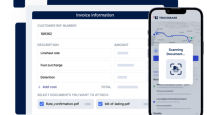Drivers Urged to Use On-the-Job Experiences to Update Vendors’ Navigation Map Software
By Timothy Cama, Staff Reporter
This story appears in the Nov. 25 print edition of Transport Topics.
For some routing technology companies, feedback from the front lines — the truck drivers who can see first-hand when something in the road does not conform to what their navigation devices say — can be some of the most valuable information on their maps.
Companies that provide navigation software for trucking fleets get their data from a variety of sources, including map databases, state departments of transportation and municipalities. But when it comes to finding and correcting errors in their products, feedback from drivers is greatly appreciated.
“The feedback loop is very important to us to make sure we maintain the highest quality data but also to make drivers’ lives easier on the road,” said Dave Marsh, vice president of research and development at Rand McNally, which specializes in truck-specific navigation devices and is based in Skokie, Ill.
“It really helps on both ends,” he said. “It certainly helps us, but we’ve also tried to make it something that helps the driver as well.”
Navigation companies have encouraged truck drivers to send them map corrections or updates in recent years by making it easy to mark problem spots while they drive, fill out more information on the issues later and submit the data electronically. The navigation providers then have systems in place to research and verify the data, and then incorporate the information into their maps, if necessary.
Rand McNally and Telogis Inc. allow drivers to mark problem spots while they drive, using a couple of clicks on their routing device. This saves the locations of problem spots and allows users to fill in more information about them later.
Dispatchers and other carrier officials also can participate by sending corrections or feedback they gather from drivers.
“We do have a whole data team within our customer support team” dedicated to collecting information from drivers and carrier officials, said Erin Cave, director of product management for navigation at Telogis Inc., which is headquartered in Aliso Viejo, Calif. The company produces navigation and other telematics software for a variety of mobile devices.
ALK Technologies Inc., based in Princeton, N.J., allows users of its truck-specific navigation software to submit data requests or corrections, but it encourages trucking company leaders to submit feedback instead, said Michael Kornhauser, the company’s senior vice president of enterprise solutions.
“It’s just not overly safe to have the driver messing around with the navigation while he’s driving. What we do, and what we’ve done for 30 years, is work very closely with our customers to constantly improve the data,” Kornhauser said.
Drivers “can pin their location to say there’s an address here that’s in the wrong place,” he said. “They can also tell us there’s a missing road here, or this road is named wrong or something like that.”
But while feedback from customers drives many of the updates ALK makes to its maps, receiving information through the application is not ideal, Kornhauser said.
Navigation companies said the data from drivers help to improve their maps beyond the usual information and differentiate their products from competitors.
Rand McNally processes map issue requests through a “Tell Rand” button on its devices. The same system is used for all customer feedback.
A driver can hit the “Tell Rand” button, which will flag the spot on the map so he can fill it out when he isn’t driving, Marsh said. He then can submit his requests to Rand McNally when he connects the device to a computer to download updates.
Rand McNally then sends all mapping-related requests to its geographic information system team.
“We will verify every one of these Tell Rands,” said John McAvoy, vice president of GIS engineering. “If they say there’s a low vertical clearance, we will check our sources, we will check state DOTs, we will go and verify what that vertical clearance is.”
McAvoy’s team can then incorporate the data into its maps, which drivers can update.
Data from states usually are reliable for major highways and interstates, but driver feedback can fill in important information gaps for smaller roads, McAvoy said.
“That’s where trucks get in trouble, and that’s where this feedback has become really key to helping truckers, because they are providing a lot of the feedback that is harder to get out of states and other sources,” McAvoy said.
“The amount of roads exponentially increases,” he added, indicating that when a new road opens, it probably won’t immediately appear on the routing device.
Telogis uses a similar system to process map requests from drivers, which they can submit through the application’s feedback function, Cave said.
“So when a driver’s out on the road and experiences either a low clearance or a situation where there’s extreme weather, or, God forbid, there’s a bridge collapse or something, they have the ability to send us feedback, which we get directly through the e-mail interface,” she said.
“Our support team looks on local news stations and other sources and acts accordingly,” Cave said.
Telogis gets “a couple hundred” feedback items daily from its 120,000 users, Cave said. Its customer support team sorts them and researches map-related ones, if necessary.
Telogis’ navigation application works on devices that are connected to data networks and therefore can update maps instantly when something changes, such as a collapsed bridge.
The navigation device downloads routes when drivers request them, so Telogis cannot change a route after that. But it can send alerts to drivers to warn them if something changes quickly.
“The next time the driver requests a route in that area, it’s taken out of the map network,” Cave said.
The system works differently at Rand McNally and ALK. Rand McNally requires users to attach the routing device to a computer, which will send the new information to the software provider, which then updates the map, allowing the user to have the new data integrated into the device within a day. After ALK receives new mapping data, it distributes the revised information in quarterly updates.
Telogis also can make changes to maps for specific fleets, instead of all of its customers, Cave said. This function can be helpful if a driver submits a request about a shipper’s facility, for example.
“We can specify the way a truck enters a location and exits a location,” she said.
Paragon Software Systems also provides routing software that can be amended by drivers.
“If there are localized issues with a particular section of a map that a driver feeds back, then the Paragon user is able to make changes to their copy of the map within the Paragon software quickly and easily to ensure that the Paragon [routing] plans are as accurate as possible, Paragon President William Salter said in an e-mail.
“In most instances, a client can also feed back any map discrepancies to the source data company,” he added. “Most suppliers offer a Web-based service which enables users to log any issues. These are then reviewed, verified and corrected by the map source supplier.”
The source of North American maps used by Great Britain-based Paragon is HERE, formerly known as Navteq.
“Paragon’s integration with vehicle-tracking solutions can also help a transportation planner identify and modify their copy of the map without any driver feedback necessary, by allowing planned routes to be compared against actual routes from the tracking partner,” Salter said.
To pass the information along to Paragon, whose U.S. headquarters are in Frisco, Texas, users can notify their software-support consultant using the company’s hotline service, or they can directly contact the company’s mapping team.
“The results are instant,” Salter said. “As soon as you make a change or modification to your map file, simply point the software to your user-edited copy of the installation map, and the Paragon routing and scheduling algorithm will take this into consideration and route your vehicles accordingly.”
“However, in the main, our users contact the mapping supplier directly via the online service,” Salter said, adding, “Users will check for themselves the changes they make to their copy of the map data, and this will be reflected in more accurate planning of their operations. Where they report specific map additions or corrections to the map supplier, these will be checked and validated by the map supplier before being applied to their source map files.”
The majority of ALK’s map-related feedback comes from dispatchers, driver managers and others, a system Kornhauser said is “more controlled” than processing requests from individual drivers.
“It comes from the driver via the driver manager and up that chain,” he said. “It’s not quite real-time, but it’s safer and a little more controlled.”
While ALK doesn’t lean heavily on customer feedback for its maps, it sees it as an integral part of its products.
“We don’t necessarily rely on it,” Kornhauser said. “We certainly do have other ways to get data. But at the same time, making the customers confident in the application is our utmost concern, and this is certainly an area that can affect that confidence.”
Like other providers, ALK has a team dedicated to verifying incoming data before incorporating the information into the quarterly map updates.
This process is “very valuable,” Kornhauser said.




